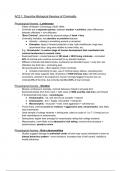Summary
WJEC Criminology Unit 2 AC2 Summary Notes
- Module
- Criminological Theories
- Institution
- WJEC
This is a summary of all the notes you will need for AC2, for the Unit 2 exam. These are my notes that I used and I got 98% in my Unit 2 exam.
[Show more]




